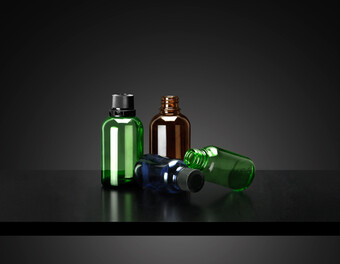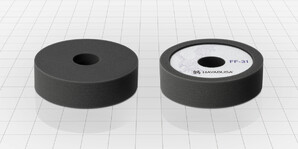- FE News»
- PPS News»
- Nov. 18, 2025
- Holiday Closing Notice [2025-2026]
- Jun. 23, 2025
- Notice of Specification Change for ECHELON Zen-Xero Series Maintenance Bags
- Oct. 31, 2024
- [News Release R-1020] Release of "ECHELON Zen-Xero DYNAMIX”
- May. 15, 2024
- [News Release R-1019] Release of "ECHELON Ver.3.0”
- Oct. 02, 2023
- [News Release R-1018]Compound that achieves a genuine finish Full Renewal of “KATANA” Series
Chemical Bottles

Bottle types
PET (polyethylene terephthalate)
PET provides glass-like transparency, gas barrier properties, chemical resistance and recyclability. PET bottles come in a wide variety of shapes and sizes. The material has low flexibility and breaks relatively easily upon impact. It is not suitable for alkaline solutions.
- Line up
- Chemical BottlesNo.1, No.2, No.3(30,100,150, 200, 300, 500ml), No.4(80, 100, 200, 300, 400ml), No.5, No.6 / C Bottle (20ml, 30ml)
PVC (polyvinyl chloride)
PVC offers transparency and excellent chemical resistance. It is flame retardant, but has poor heat and cold resistance.
- Line up
- Chemical Bottle No.7(150, 200, 260, 300, 400ml), No.8, No.9, No.10, No.17, No.18, No.19
HDPE (high density polyethylene)
This material excels in chemical resistance, moisture resistance and cost performance. It is the most commonly used commodity plastic. It cannot be used with organic solvents.
- Line up
- Chemical Bottles No.11Ring Set / Over Cap Set,No.12, No.13, No.14, No.15(30, 50, 150, 210, 250ml), No.16, No.20
GLASS
Glass offers excellent chemical resistance and preservative properties. Types of glass include colored soda-lime glass and borosilicate glass, used for screw-cap tubes. The type used depends on the shape and application.
| Bottle types | PET | PVC | HDPE |
|---|---|---|---|
| Transparency | ○ | ○ | × |
| Gloss | ○ | ○ | × |
| Alkali resistance | × | ○ | ○ |
| Acid resistance | △ | ○ | ○ |
| Alcohol resistance | ○ | ○ | △ |
| Oil resistance | ○ | ○ | △ |
| Water vapor permeability | △ | △ | ○ |
| Oxygen permeability | ○ | ○ | △ |
| Carbon dioxide permeability | ○ | ○ | × |
| Aroma permeability | ○ | △ | × |
| Heat resistance temperature | 50〜60℃ | 50〜60℃ | 50〜100℃ |
Depending on the usage conditions, deformations or deterioration over time may occur. For that reason, please thoroughly test before use.
* Do not use any combination of body and container other than those specified.
Doing so may cause leakage.
Types of caps and inner plugs
 Once you have selected a bottle to use, choose a cap and inner plug that fit it. Whether or not a cap or inner plug can be used depends on the type of container. The container pages in the catalogue indicate which caps and inner plugs are compatible with each container. Please consult those pages when making your selection.
Once you have selected a bottle to use, choose a cap and inner plug that fit it. Whether or not a cap or inner plug can be used depends on the type of container. The container pages in the catalogue indicate which caps and inner plugs are compatible with each container. Please consult those pages when making your selection.If you wish to use a different combination, please contact us.
Additionally, please be sure to thoroughly test the bottle with liquid inside before using it.
Original bottles and labels
 Once you have decided on a bottle and cap to use, you will need labels and cautionary notes suitable for the contents.
Once you have decided on a bottle and cap to use, you will need labels and cautionary notes suitable for the contents.Of course, it is often enough to simply use the pre-existing labels in our lineup. If you want to differentiate from other companies or use the bottles for a special purpose, however, you will need customized labels.
We offer a range of services to meet your needs, including original labels, printing directly on the bottles and bottles in original shapes.
Feel free to contact us for advice.

Bottle types
PET (polyethylene terephthalate)
PET provides glass-like transparency, gas barrier properties, chemical resistance and recyclability. PET bottles come in a wide variety of shapes and sizes. The material has low flexibility and breaks relatively easily upon impact. It is not suitable for alkaline solutions.
- Line up
- Chemical BottlesNo.1, No.2, No.3(30,100,150, 200, 300, 500ml), No.4(80, 100, 200, 300, 400ml), No.5, No.6 / C Bottle (20ml, 30ml)
PVC (polyvinyl chloride)
PVC offers transparency and excellent chemical resistance. It is flame retardant, but has poor heat and cold resistance.
- Line up
- Chemical Bottles No.7(150, 200, 260, 300, 400ml), No.8, No.9, No.10, No.17, No.18, No.19
HDPE (high density polyethylene)
This material excels in chemical resistance, moisture resistance and cost performance. It is the most commonly used commodity plastic. It cannot be used with organic solvents.
- Line up
- Chemical Bottles No.11Ring Set / Over Cap Set, No.12, No.13, No.14, No.15(30, 50, 150, 210, 250ml), No.16, No.20
GLASS
Glass offers excellent chemical resistance and preservative properties. Types of glass include colored soda-lime glass and borosilicate glass, used for screw-cap tubes. The type used depends on the shape and application.
| Bottle types | PET | PVC | HDPE |
|---|---|---|---|
| Transparency | ○ | ○ | × |
| Gloss | ○ | ○ | × |
| Alkali resistance | × | ○ | ○ |
| Acid resistance | △ | ○ | ○ |
| Alcohol resistance | ○ | ○ | △ |
| Oil resistance | ○ | ○ | △ |
| Water vapor permeability | △ | △ | ○ |
| Oxygen permeability | ○ | ○ | △ |
| Carbon dioxide permeability | ○ | ○ | × |
| Aroma permeability | ○ | △ | × |
| Heat resistance temperature | 50〜60℃ | 50〜60℃ | 50〜100℃ |
Depending on the usage conditions, deformations or deterioration over time may occur. For that reason, please thoroughly test before use.
* Do not use any combination of body and container other than those specified.
Doing so may cause leakage.
Types of caps and inner plugs
 Once you have selected a bottle to use, choose a cap and inner plug that fit it. Whether or not a cap or inner plug can be used depends on the type of container. The container pages in the catalogue indicate which caps and inner plugs are compatible with each container. Please consult those pages when making your selection.
Once you have selected a bottle to use, choose a cap and inner plug that fit it. Whether or not a cap or inner plug can be used depends on the type of container. The container pages in the catalogue indicate which caps and inner plugs are compatible with each container. Please consult those pages when making your selection.If you wish to use a different combination, please contact us.
Additionally, please be sure to thoroughly test the bottle with liquid inside before using it.
Original bottles and labels
 Once you have decided on a bottle and cap to use, you will need labels and cautionary notes suitable for the contents.
Once you have decided on a bottle and cap to use, you will need labels and cautionary notes suitable for the contents.Of course, it is often enough to simply use the pre-existing labels in our lineup. If you want to differentiate from other companies or use the bottles for a special purpose, however, you will need customized labels.
We offer a range of services to meet your needs, including original labels, printing directly on the bottles and bottles in original shapes.。
Feel free to contact us for advice.



























































